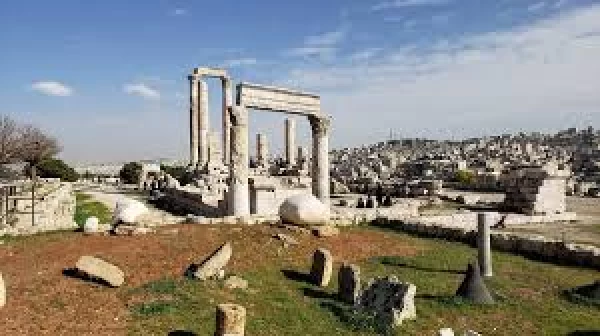
Temple of Hercules
The Temple of Hercules is a historical building located within the Amman Citadel in the center of the capital. It is considered one of the most important Roman buildings remaining today in the city and larger than any Roman temple built in Rome itself. It dates back to the second century AD. The remaining part of this building is one of the most important landmarks of the city of Amman at present, which symbolizes it and its history.
According to some of the inscriptions found on the site. Today one remaining facade of the temple is made up of six colossal columns, as well as some other columns from other palace rooms.
The name of the temple was dedicated to Hercules, one of the Roman deities whose mission and function was to protect the city. It is noteworthy that a colossal statue of Hercules was built at the entrance to the temple, where there are remnants of the hand.
It has two rows of columns, each of which is 9 meters high, and the diameter of each column is 1.5 meters. Above the columns are capitals of the Corinthian style. The columns are linked by high lintels, each of which is 7 meters long. Excavations have indicated that there are incomplete columns; This supports the hypothesis that the building was structurally incomplete.
As for these days, only a few columns remain of this huge and grandiose building. The Ministry of Tourism and Antiquities, in cooperation with the American Center for Oriental Research, renovated the building in the early nineties of the last century to be in its current form.
Hand of Hercules/
During the excavation process, only a few clues were left to help scientists solve the mysteries of this huge, semi-deserted temple. But the ones that did exist were huge - albeit mysterious. Of only three giant fingers, one elbow, and a scattering of coins, archaeologists agreed that these marble body parts most likely belonged to a colossal statue of Hercules himself. Therefore, the theory goes, the temple must also have been dedicated to a demigod known for his feats of strength and far-reaching adventures.
It is possible that the statue was toppled during one of the periodic catastrophic earthquakes in the area, the statue fell into small pieces, but unlike the temple, all but the hand and elbow are all gone. In the words of one guide, “The rest of Hercules became work surfaces in Oman.”
Experts' best guess is that the statue, in its original state, would have been up to 40 feet tall, making it among the largest marble statues ever known.
Latest Articles
Admin
Seabourn Sojourn Cruise Stops in Safaga Port
The Seabourn Sojourn, the flagship vessel of Seabourn Cruise Line's ultra-luxury fleet, was built in 2008 at the T. Mariotti shipyard in Genoa, Italy. Measuring 198 metres, it can accommodate up to 450 guests in its 225 spacious all-suite staterooms.
Admin
Norwegian Sky Cruise Stops in Safaga Port
Norwegian Cruise Line operates a cruise ship called the Norwegian Sky. It was constructed in 1999 and can accommodate 2,004 passengers in addition to 878 crew members. The ship has several dining establishments, lounges and bars, a spa and fitness center, swimming pools, and a number of entertainment areas.
Admin
Explora II Cruise Stops in Safaga Port
Explora II, the second vessel in the Explora Journeys fleet, sets sail in 2024 to redefine luxury cruising. With 461 ocean-front suites, 9 culinary experiences, and 4 pools, this haven of sophistication and sustainability promises an unforgettable "Ocean State of Mind" journey to inspiring destinations.
Admin
Mein Schiff 6 Cruise Stops in Safaga Port
The Mein Schiff 6 is the latest cruise ship in the renowned TUI Cruises fleet, offering passengers a luxurious and sophisticated cruise experience. At 315 metres long, this floating resort features a range of dining options, entertainment, and recreational facilities, including a spa, fitness centre, and sports amenities.
Admin
Mein Schiff 4 Cruise Stops in Safaga Port
When the Mein Schiff 4 cruise ship docks in Safaga, Egypt, passengers are granted access to a realm of ancient wonders. Aboard this state-of-the-art vessel, guests can embark on meticulously curated shore excursions that showcase the region's most iconic landmarks, including the Giza Pyramids, the enigmatic Sphinx, and the remarkable tombs and temples of the Valley of the Kings in Luxor.
Admin
MS Europa Cruise Stops in Safaga Port
The Silver Moon, Silversea's latest flagship, is a luxury cruise ship that offers an exceptional travel experience for Venezuelans exploring Egypt. With a capacity of 596 guests and an impressive 40,700 gross tonnes, the Silver Moon maintains the small-ship intimacy and spacious all-suite accommodations that are the hallmarks of the Silversea brand.













